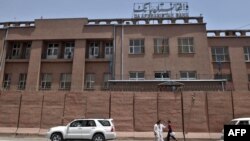Facing economic paralysis and a nationwide humanitarian crisis, Afghanistan needs to stay current on what it owes international economic institutions before it can receive critically needed foreign assistance. How much the country owes and who should pay off the debts are unclear.
Despite having no representation at the World Bank, the de facto Taliban government paid about $5 million to the bank in June toward Afghanistan’s debt.
Last month, the United States transferred $3.5 billion in Afghan central bank assets previously frozen in New York to a Swiss bank, and officials said some of the funds might be used to pay Afghanistan’s debts to international institutions.
Paying off debt that has come due will “unlock much greater resources for basic services in Afghanistan,” U.S. Special Representative for Afghanistan Thomas West said during a discussion last month at the Center for Strategic and International Studies while explaining the potential use of Afghan assets in safeguarding the country’s economy.
“Aid reception is contingent upon the scheduled loan repayments before it becomes an arrear or an outstanding loan,” Zia-u-Rahman Haleemi, a former Afghan representative at the World Bank, told VOA. “A very small amount in outstanding arrears could potentially block a huge amount in aid.”
A spokesperson for the World Bank did not answer a question about the extent of Afghanistan’s existing arrear but pointed to a 2018 report that put the country’s total debts to the World Bank and the Asian Development Bank at about $1 billion.
“Afghanistan has memberships in international bodies that have membership fees. If the Taliban do not pay those fees, then they could be paid from the Afghan funds,” Anwar ul-Haq Ahady, a former Afghan finance minister who now sits on the four-member board of trustees for the management of the Afghan funds in the Swiss bank, told VOA’s Afghan service recently.
A spokesman for the Afghanistan central bank received but did not respond to VOA’s questions about the Taliban’s willingness to pay current and future arrears to the World Bank and other international institutions.
Like most Western donors, the World Bank has stopped aid to Afghan state agencies and has instead channeled assistance programs and funds through the United Nations and international nongovernment organizations.
“All projects are being implemented off-budget outside of the interim Taliban administration,” a World Bank spokesperson told VOA, adding that the bank has given $893 million to U.N. agencies and NGOs.
Assets in European banks
Prior to the collapse of the former Afghan government, Afghanistan maintained more than $9 billion in financial assets, mostly in U.S. and European banks. The assets were used primarily to stabilize the Afghan currency market and address other national financial issues.
The Taliban’s return to power has scattered the national assets in different banks and under different, sometimes unclear, circumstances.
Half of Afghanistan’s $7 billion bank assets remain frozen in the U.S. due to ongoing litigation by families of some victim of the September 11, 2001, attacks on the U.S., despite a recommendation by a federal judge that the funds were immune from the court’s jurisdiction.
About $2 billion in additional Afghan financial assets are frozen in European banks.
“I think the $2 billion held in Europe should be unfrozen and combined with the Afghan Fund [in the Swiss bank],” said Mohsin Amin, an Afghan policy analyst.
Like the U.S., European countries have refused to recognize the Taliban’s de facto leadership and have accused the Taliban of lacking legitimacy and perpetrating egregious human rights violations.
“There has not been any declaration by political leaders of the European countries where the $2.1 billion DAB [Da Afghanistan Bank] funds are held that they are ‘frozen.’ But in practice, it is exact that these $2.1 billion are out of reach of the DAB, as the private banks where they are located are not responsive to the DAB requests,” Jean-François Cautain, a former European Union ambassador, told VOA.
Save, but for how long?
Despite extricating half of the Afghan assets from litigation in the U.S. and the official announcements that the funds will be used to stabilize the Afghan economy, the overall preference is to save the money and not spend any amount on humanitarian or development needs, according to Ahady and West.
It is unclear how long the funds will remain dormant in the Swiss bank and how saving the assets will resuscitate the crippled Afghan economy.
U.S. officials have said that neither recognition of nor lifting sanctions on the Taliban is on their immediate agenda.
While defying widespread domestic and external calls for the formation of an inclusive government and respect to women’s rights, Taliban authorities have accused the U.S. of choking the Afghan economy.
Groups advocating a total release of Afghan assets say the asset freeze, financial sanctions and the Taliban’s bad governance have essentially paralyzed the Afghan economy, causing immense suffering for ordinary Afghans.
“While the $3.5 billion moved to Switzerland may be safeguarded from litigation in the U.S., the fundamentals have not changed. The Afghan economy and banking system remains paralyzed — at enormous human cost to regular Afghan citizens — because of political decisions taken by the U.S. and its allies,” United Against Inhumanity, an international organization advocating against war atrocities, said in a statement on October 4.
U.S. officials say the assets freeze and sanctions are targeting Taliban officials and that the U.S. has maintained robust humanitarian assistance to the people of Afghanistan with more than $1 billion given to U.N. agencies and international NGOs.








